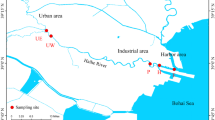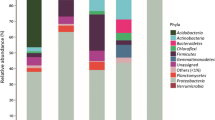Abstract
Purpose
The aim of this study was to detect three triazine pesticides and their metabolites in the drip water and the sediment of the Amaterska cave system. Diversity of the bacterial community in the sediment was also assessed, and the potential role of bacteria in degradation of these pesticides was evaluated.
Materials and methods
Triazines and their metabolites were analyzed in the soil, drip water, and sediment of the Amaterska cave system area in seven sampling sites (S1–S7) based on the above ground cover that included forest, permanent grassland, and agriculture cropland. The bacterial community in the cave sediments (S1–S6) was also analyzed using the Illumina sequencing of the V3 and V4 regions of 16S rDNA.
Results and discussion
Triazines were present in the soil and drip water in all sites below grassland and agricultural land but not under the forest area. Only atrazine metabolites were detected in the surface soil. In contrast, atrazine was detected in all cave sediments regardless of above ground cover, and this is likely due to the occasional alluvial influx. The overall prevalence of bacteria potentially capable of atrazine degradation in the cave sediment ranged from 13.4 to 64.0% of the entire bacterial community. The concentrations of atrazine in the cave sediment were 16 to 70 times higher than in those in drip water.
Conclusions
High concentrations of atrazine in the cave sediment indicate a slow degradation rate of triazines in the cave likely due to low temperatures and absence of photolysis. The main source of atrazine in the Amaterska cave system is likely not drip water but the alluvial influx. Bacteria potentially capable of triazine degradation in the cave sediment were detected; however, their role in this process remains to be investigated.


Similar content being viewed by others

References
Arias-Estévez M, López-Periago E, Martínez-Carballo E, Simal-Gándara J, Mejuto J-C, García-Río L (2008) The mobility and degradation of pesticides in soil and the pollution of groundwater resources. Agric Ecosyst Environ 132:247–260
Baldini JUL, McDermott F, Fairchild IJ (2006) Spatial variability in cave drip water hydrochemistry: implications for stalagmite paleoclimate records. Chem Geol 235:390–404
Brooks RW, Parker BC, Gruft H, Falkinham JO III (1984) Epidemiology of infection by non-tuberculous mycobacteria. V. Numbers in eastern United States soils and correlation with soil characteristics. Am Rev Respir Dis 130:630–633
Caporaso JG, Kuczynski J, Stombaugh J et al (2010) QIIME allows analysis of high-throughput community sequencing data. Nat Methods 7:335–336
Commission Decision (2004) 2004/248/EC concerning the non-inclusion of atrazine in Annex I to Council Directive 91/414/EEC and the withdrawal of authorisations for plant protection products containing this active substance
Dehghani M, Nasseri S, Amin S, Naddafee K, Taghavi M, Yunesian M, Maleky N (2007) Isolation and identification of atrazine-degrading bacteria from corn field soil in Fars province of Iran. Pak J Biol Sci 10:84–89
Devers M, El Azhari N, Kolic NU, Martin-Laurent F (2007) Detection and organization of atrazine-degrading genetic potential of seventeen bacterial isolates belonging to divergent taxa indicate a recent common origin of their catabolic functions. FEMS Microbiol Lett 273:78–86
Dong X, Sun H (2016) Effect of temperature and moisture on degradation of herbicide atrazine in agricultural soil. Int J Environ Agric Res 2:150–157
Engbaek HC, Vergmann B, Weis Bentzon B (1967) The sodium lauryl sulphate method in culturing sputum for mycobacteria. Scand J Respir Dis 48:268–284
Faimon J, Bodláková R, Pracný P, Hebelka J (2016) Transfer of climatic variables by dripwater: a case study from Kateřinská cave (Moravian karst). Environ Earth Sci 75:1151
Fan X, Song F (2014) Bioremediation of atrazine: recent advances and promises. J Soils Sediments 14:1727–1737
Hartland A, Fairchild IJ, Lead JR, Borsato A, Baker A, Frisia S, Baalousha M (2012) From soil to cave: transport of trace metals by natural organic matter in karst dripwaters. Chem Geol 304–305:68–82
Hrnčiarová T, Mackovčin P, Zvara I et al. (2009) Atlas of landscape of the Czech Republic. Ministerstvo životního prostředí ČR a Výzkumný ústav Silva Taroucy pro krajinu a okrasné zahradnictví, v.v.i., Praha
Iker BC, Kambesis P, Oehre SA, Groves C, Barton HA (2010) Microbial atrazine breakdown in a karst groundwater systém and its effect on ekosystém energetics. J Environ Qual 39:509–518
Kalkhoff SJ, Kolpin DW, Thurman EM, Ferrer I, Barcelo D (1998) Degradation of chloroacetanilide herbicides: the prevalence of sulfonic and oxanilic acid metabolites in Iowa groundwaters and surface waters. Environ Sci Technol 32:1738–1740
Kamas J, Bruthans J, Vysoka H, Kovařík M (2015) Range of horizontal transport and residence time of nitrate in a mature karst vadose zone. Int J Speleol 44:49–59
Kluge T, Riechelmann DFC, Wieser M, Spötl C, Sültenfuβ J, Schröder-Ritzrau A, Niggemann S, Aeschbach-Hertig W (2010) Dating cave drip water by tritium. J Hydrol 394:396–406
Kogovšek J, Petrič M (2013) Increase of vulnerability of karst aquifers due to leakage from landfills. Environ Earth Sci 70:901–912
Kolpin DW, Barbash JE, Gilliom RJ (1998) Occurrence of pesticides in shallow ground water of the United States: initial results from the water-quality assessment program. Environ Sci Technol 32:558–566
Kontchou CY, Gschwind N (1999) Biodegradation of s-triazine compounds by a slable mixed bacterial community. Ecotoxicol Environ Saf 43:47–56
Kruger EL, Somasundaram L, Kanwar RS, Coats JR (1993) Persistence and degradation of [C-14] atrazine and [C-14] deisopropylatrazine as affected by soil depth and moisture conditions. Environ Toxicol Chem 12:1956–1967
Loos R, Locoro G, Comero S, Contini S, Schwesig D, Werres F, Balsaa P, Gans O, Weiss S, Blaha L, Bolchi M, Gawlik BM (2010) Pan-European survey on the occurrence of selected polar organic persistent pollutants in ground water. Water Res 44:4115–4126
Mahler BJ, Personne JC, Lods GF, Drogue C (2000) Transport of free and particulate-associated bacteria in karst. J Hydrol 238:179–193
Modra H, Bartos M, Hribova P, Ulmann V, Hubelova D, Konecny O, Gersl M, Kudelka J, Voros D, Pavlik I (2017) Mycobacteria in the Moravian karst environment (bull rock cave and the relevant water catchment area): the impact of water sediments, earthworm castings and bat faeces. Vet Med-Czech 62:153–168
Monard C, Vandenkoornhuyse P, Le Bot B, Binet F (2011) Relationship between bacterial diversity and function under biotic control: the soil pesticide degraders as a case study. ISME J 5:1048–1056
Nossa CW, Oberdorf WE, Yang L, Aas JA, Paster BJ, Desantis TZ, Brodie EL, Malamud D, Poles MA, Pei Z (2010) Design of 16S rRNA gene primers for 454 pyrosequencing of the human foregut microbiome. World J Gastroenterol 16:4135–4144
Parashar D, Chauhan DS, Sharma VD, Chauhan A, Chauhan SVS, Katoch VM (2004) Optimalization of procedures for isolation of mycobacteria from soil and water samples obtained in northern India. Appl Environ Microbiol 70:3751–3753
Perrin J, Jeannin PY, Zwahlen F (2003) Epikarst storage in a karst aquifer: a conceptual model based on isotopic data, Milandre test site, Switzerland. J Hydrol 279:106–124
Portaels F, De Muynck A, Sylla MP (1988) Selective isolation of mycobacteria from soil: a statistical analysis approach. J Gen Microbiol 134:849–855
Pronk M, Goldscheider N, Zopfi J, Zwahlen F (2009) Percolation and particle transport in the unsaturated zone of a karst aquifer. Ground Water 47:361–369
Radosevich M, Martin EC, Ghosh D, Roy K, Peacock A, White DC (2006) In situ enrichment with BioSep beads yields diverse and metabolically novel atrazine degrading soil bacteria. The ASA-CSSA-SSSA International Annual Meetings
Roberts T (ed) (1998) Metabolic pathways of agrochemicals. Part one. Herbicides and plant growth regulators. The Royal Society of Chemistry, Cambridge
Rousseaux S, Hartmann A, Soulas G (2001) Isolation and characterisation of new gram-negative and gram-positive atrazine degrading bacteria from different French soils. FEMS Microbiol Ecol 36:211–222
Schwartz K, Barth JAC, Postigo-Rebollo C, Grathwohl P (2009) Mixing and transport of water in a karst catchment: a case study from precipitation via seepage to spring. Hydrol Earth Syst Sci 13:285–292
Shabarova T, Villiger J, Morenkov O, Niggemann J, Dittmar T, Pernthaler J (2014) Bacterial community structure and dissolved organic matter in repeatedly flooded subsurface karst water pools. FEMS Microbiol Ecol 89:111–126
Sheng G, Johnston CT, Teppen BJ, Boyd SA (2001) Potential contribution of smectite clays and organic matter to pesticide retention in soils. J Agric Food Chem 49:2899–2907
Smith D, Alvey S, Crowley DE (2005) Cooperative catabolic pathways within an atrazine-degrading enrichment culture isolated from soil. FEMS Microbiol Ecol 53:265–273
Trček B (2007) How can the epikarst zone influence the karst aquifer behaviour? Environ Geol 51:761–765
Ulmann V, Kracalikova A, Dziedzinska R (2015) Mycobacteria in water used for personal hygiene in heavy industry and collieries: a potential risk for employees. Int J Environ Res Public Health 12:2870–2877
Wiliams PW (2008) The role of epikarst in karst and cave hydrogeology: a review. Int J Speleol 37:1–10
Acknowledgements
This work was supported by the Czech Science Foundation (No. 16-13231S). We thank prof. Ludek Zurek from K-State University for English improvement and commenting on a former version of the manuscript.
Author information
Authors and Affiliations
Corresponding author
Additional information
Responsible editor: Jan Schwarzbauer
Electronic supplementary material
ESM 1
(DOCX 18 kb).
Rights and permissions
About this article
Cite this article
Modrá, H., Gruberová, E., Konečný, O. et al. Influx and concentration of triazine pesticides in the Amaterska cave system, Moravian Karst, Czech Republic. J Soils Sediments 18, 640–647 (2018). https://doi.org/10.1007/s11368-017-1831-0
Received:
Accepted:
Published:
Issue Date:
DOI: https://doi.org/10.1007/s11368-017-1831-0



